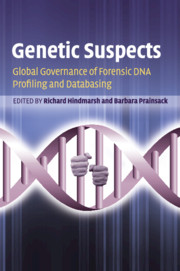Book contents
- Frontmatter
- Contents
- List of contributors
- About the contributors
- Foreword
- Acknowledgements
- 1 Introducing Genetic Suspects
- Section 1 Key areas in DNA profiling and databasing
- Section 2 National contexts of forensic DNA technologies and key issues
- Section 3 Conclusions
- 16 Beyond borders: trends and challenges in global forensic profiling and databasing
- Index
- References
16 - Beyond borders: trends and challenges in global forensic profiling and databasing
from Section 3 - Conclusions
Published online by Cambridge University Press: 05 October 2012
- Frontmatter
- Contents
- List of contributors
- About the contributors
- Foreword
- Acknowledgements
- 1 Introducing Genetic Suspects
- Section 1 Key areas in DNA profiling and databasing
- Section 2 National contexts of forensic DNA technologies and key issues
- Section 3 Conclusions
- 16 Beyond borders: trends and challenges in global forensic profiling and databasing
- Index
- References
Summary
This book did not set out to evaluate or assess the phenomenon of forensic DNA databasing in any normative way. As editors, we did not approach this book project with a particular message in mind that we sought to get across. Neither did we encourage our contributors to present linear and causal interpretations of the emergence and governance of forensic DNA databases. Instead, we encouraged them to provide ‘thick descriptions’ (Geertz 1973) of how forensic DNA profiling and databases operate in different criminal justice systems, and in different societal/political systems, more broadly.
In this context, the analyses were carried out in the tradition of analysing technology-in-practice (Timmermans and Berg 2003). This means that we sought to avoid technological determinism, namely the analysis of policy-making and societal developments in the field of forensic DNA databasing as resulting from, or being driven by, the technology that underpins practices in the field. We also sought to avoid the opposite approach, namely to regard forensic DNA databases merely as a technology through which political and societal values are enforced and realised (Timmermans and Berg 2003). In other words, our contributors set out to provide a better understanding of how forensic DNA databases are enacted, discussed and regulated, and what the implications of these insights are for governance.
To allow for a strong comparative component, we invited contributions from authors at the forefront of discussions on regulatory, ethical and operational governance aspects of forensic DNA databases in a range of countries.
- Type
- Chapter
- Information
- Genetic SuspectsGlobal Governance of Forensic DNA Profiling and Databasing, pp. 333 - 341Publisher: Cambridge University PressPrint publication year: 2010



